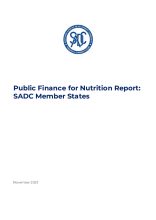The Southern African Development Community (SADC) is a body of 16 Member States, striving for regional integration and poverty eradication. In the Region, child malnutrition remains a concern, with stunting rates surpassing 25% in most Member States. The Region’s 19 million stunted children represent a third of all cases in Africa. Additionally, six SADC countries have child-wasting rates exceeding 5%. Stunting and wasting are closely linked to compromised brain development and result in negative macroeconomic implications. Evidence shows that across 95 low- and middle-income countries stunting’s long-lasting effects result in reduced income earning potential for individuals and costs to the private sector of up to USD 135.4 million annually, equating to 0.01 to 1.2% of GDP.
In the case of SADC Member States, as a general trend, a higher prevalence of stunting correlates with a lower per capita GDP in 2021. Given the significant impact of malnutrition on child development and its macroeconomic implications, mobilising adequate resources should be a policy priority. However, without routine tracking of nutrition expenditure, it is not possible to discern which programmes are being allocated funding, nor how much is being spent on these multi-sectoral programmes.

